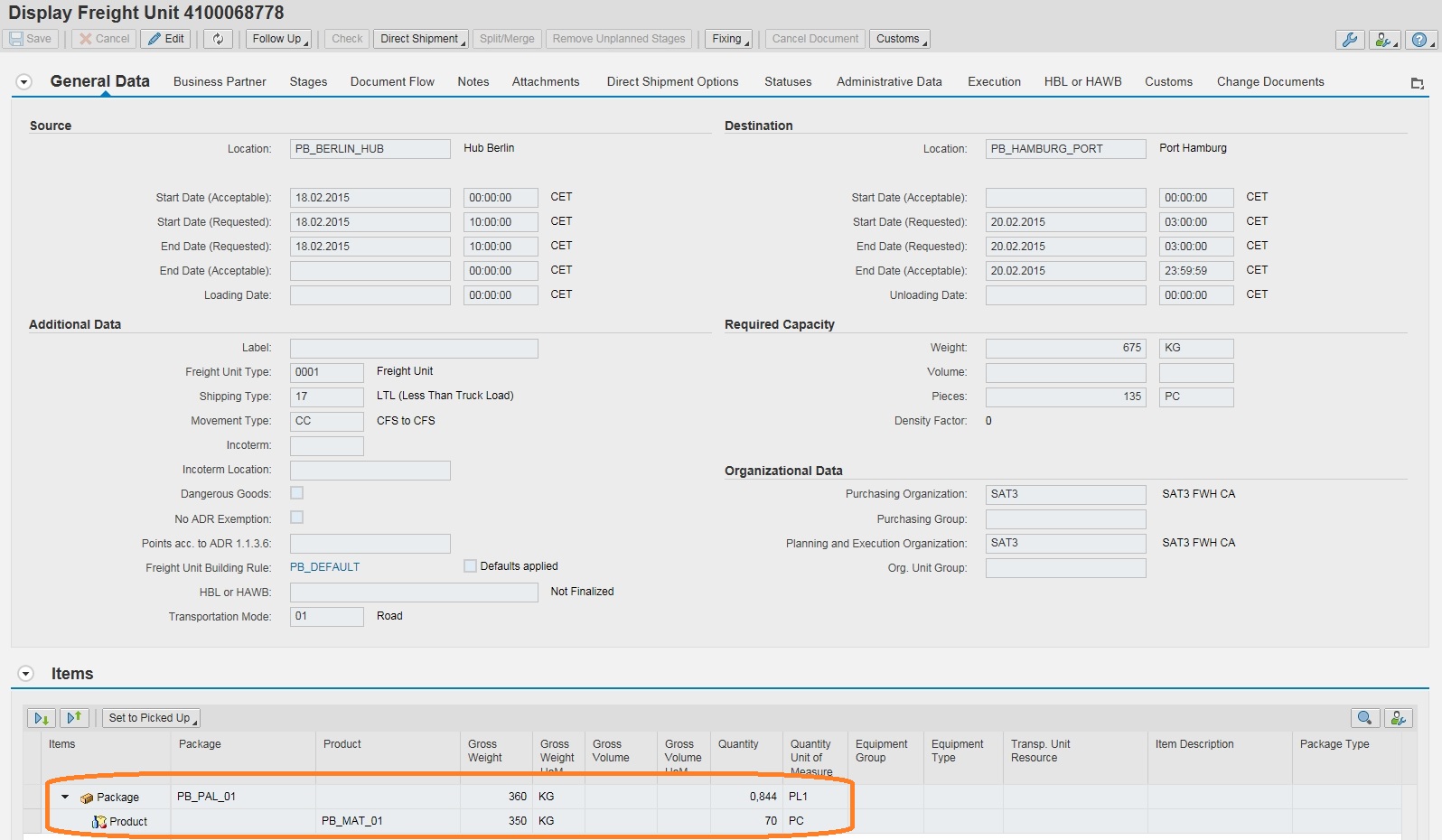
- SAP Community
- Products and Technology
- Supply Chain Management
- SCM Blogs by SAP
- Monday Knowledge Snippet (MKS) - 57 TM 9.3 Package...
- Subscribe to RSS Feed
- Mark as New
- Mark as Read
- Bookmark
- Subscribe
- Printer Friendly Page
- Report Inappropriate Content
The last MKS explained the setup of the TM 9.3 Package Builder including the assignment of the to-be-used package type and required master data definitions. Now lets roll!
For the created Forwarding Order Type having the package building activated using the Freight Unit Building rule, we create an order and enter the mandatory fields (I focus today on the items as this is no FWO MKS 😉 ). Having defined the start and destination, entered some times, and maybe business partner, I add the very first product to the order. In my example 70 pieces.

When saving the order, the Freight Unit Builder runs and creates depending on my setting the FUs for planning. I can see this in the order under document flow:

Checking the FU, I find under the items now some new information:

The Package Builder has created a new package item for my ordered product. I can see that it:
- used the package material (PB_PAL_01) and unit of measure (PL1) I have defined in the product - package type assignment
- calculated the quantity (90 pieces make up a full pallet, the package quantity for an incomplete package is calculated actual height (product layer stack plus package material height) / defined maximum height)
- considered the package material weight (10 kg)
- filled the package item dimensions (length, width, height)
Remember, the PB can only this when the required definitions are available. Whenever something is missing, the FU item will look like the FWO item.
Next step would be to increase the product quantity in the order item, let us say to 100. Result now is a full package (90 pieces) and an incomplete package (10 pieces). Again increasing the product quantity and having set a limit of packages per FU, you can force the FUB to create more than just 1 FU. For example having set this limit to 2 and ordering 200 pieces of the product, should create an FU containing 2 full packages and another FU with 1 package (20 pieces).
Making it a bit more interesting, I add more products:

The PB considers now the available definitions and creates an FU looking like this:

The FU now contains 2 mixed packages. From here on it gets complicated as you might guess. In my example the PB did split the product PB_MAT_01 and put it on 2 different mixed packages. Of course it is possible to steer this and for example force the function to keep this product together. I did not do this to trigger some discussion here... 🙂
Next MKS will finally focus on the PB logic and the different steps it applies.
- SAP Managed Tags:
- SAP Transportation Management
You must be a registered user to add a comment. If you've already registered, sign in. Otherwise, register and sign in.
-
Business Trends
169 -
Business Trends
23 -
Catalog Enablement
1 -
Event Information
47 -
Event Information
4 -
Expert Insights
12 -
Expert Insights
38 -
intelligent asset management
1 -
Life at SAP
63 -
Product Updates
500 -
Product Updates
65 -
Release Announcement
1 -
SAP Digital Manufacturing for execution
1 -
Super Bowl
1 -
Supply Chain
1 -
Sustainability
1 -
Swifties
1 -
Technology Updates
187 -
Technology Updates
17
- From Shipment to Container, Gain Logistics Visibility at a More Granular Level in Supply Chain Management Blogs by SAP
- SAP S/4HANA 2023 FPS1: Improved integration of purchase scheduling agreements with TM in Supply Chain Management Blogs by SAP
- Freight Unit Building for Outbound Delivery Order created in EWM in Supply Chain Management Q&A
- FUBR with multiple unit of measures (MT , EA , CASE) in Supply Chain Management Q&A
- Synchronizing Purchase Scheduling Agreements with TM Transport Planning in Supply Chain Management Blogs by SAP
| User | Count |
|---|---|
| 9 | |
| 8 | |
| 6 | |
| 4 | |
| 3 | |
| 3 | |
| 3 | |
| 3 | |
| 3 | |
| 3 |